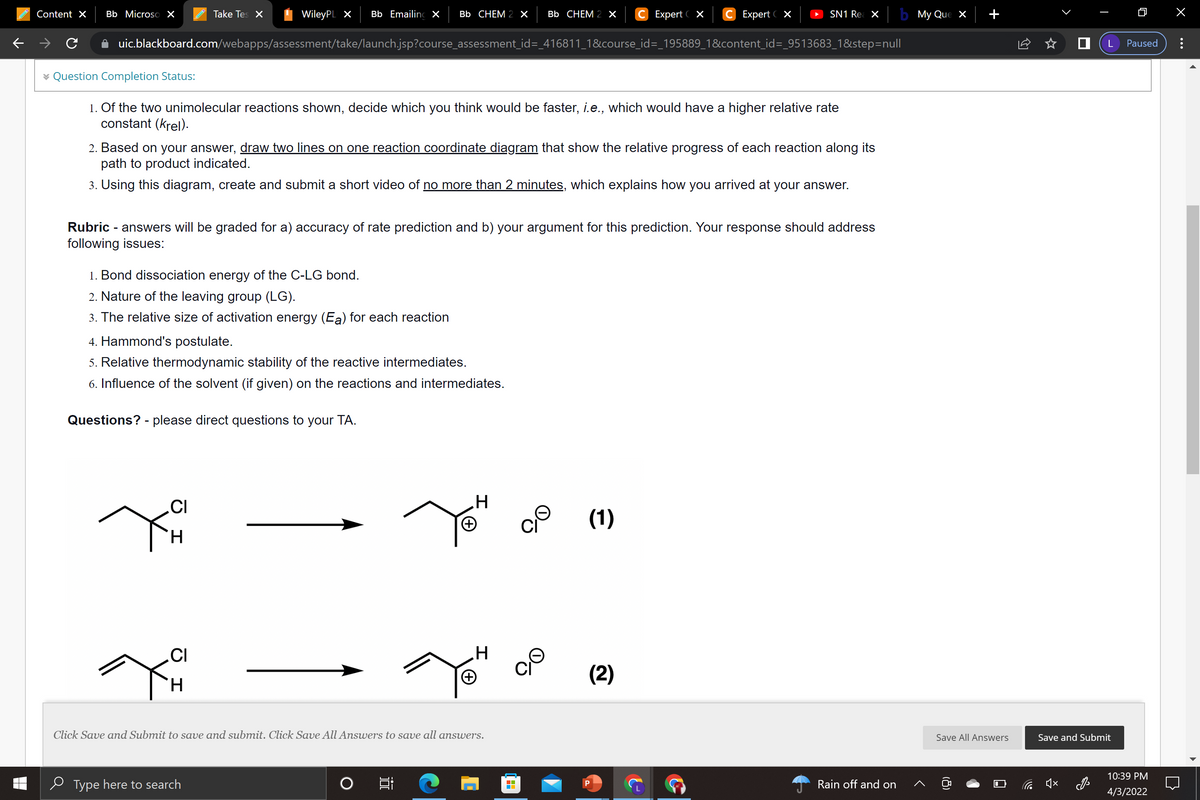Bb Microso x I Bb Emailin x Bb CHEM 2 X Bb CHEM 2 X с C Expert X b My Que x + Content x Take Te X WileyPL X Expert X O SN1 Re X i uic.blackboard.com/webapps/assessment/take/launch.jsp?course_assessment_id=_416811_1&course_id=_195889_1&content_id=_9513683_1&step=null Paused * Question Completion Status: 1. Of the two unimolecular reactions shown, decide which you think would be faster, i.e., which would have a higher relative rate constant (krel). 2. Based on your answer, draw two lines on one reaction coordinate diagram that show the relative progress of each reaction along its path to product indicated. 3. Using this diagram, create and submit a short video of no more than 2 minutes, which explains how you arrived at your answer. Rubric - answers will be graded for a) accuracy of rate prediction and b) your argument for this prediction. Your response should address following issues: 1. Bond dissociation energy of the C-LG bond. 2. Nature of the leaving group (LG). 3. The relative size of activation energy (Ea) for each reaction 4. Hammond's postulate. 5. Relative thermodynamic stability of the reactive intermediates. 6. Influence of the solvent (if given) on the reactions and intermediates. Questions? - please direct questions to your TA. .CI (1) CI (2) H. Click Save and Submit to save and submit. Click Save All Answers to save all answers. Save All Answers Save and Submit 10:39 PM O Type here to search Ai * Rain off and on 4/3/2022
Bb Microso x I Bb Emailin x Bb CHEM 2 X Bb CHEM 2 X с C Expert X b My Que x + Content x Take Te X WileyPL X Expert X O SN1 Re X i uic.blackboard.com/webapps/assessment/take/launch.jsp?course_assessment_id=_416811_1&course_id=_195889_1&content_id=_9513683_1&step=null Paused * Question Completion Status: 1. Of the two unimolecular reactions shown, decide which you think would be faster, i.e., which would have a higher relative rate constant (krel). 2. Based on your answer, draw two lines on one reaction coordinate diagram that show the relative progress of each reaction along its path to product indicated. 3. Using this diagram, create and submit a short video of no more than 2 minutes, which explains how you arrived at your answer. Rubric - answers will be graded for a) accuracy of rate prediction and b) your argument for this prediction. Your response should address following issues: 1. Bond dissociation energy of the C-LG bond. 2. Nature of the leaving group (LG). 3. The relative size of activation energy (Ea) for each reaction 4. Hammond's postulate. 5. Relative thermodynamic stability of the reactive intermediates. 6. Influence of the solvent (if given) on the reactions and intermediates. Questions? - please direct questions to your TA. .CI (1) CI (2) H. Click Save and Submit to save and submit. Click Save All Answers to save all answers. Save All Answers Save and Submit 10:39 PM O Type here to search Ai * Rain off and on 4/3/2022
Chapter8: Sampling, Standardization, And Calibration
Section: Chapter Questions
Problem 8.12QAP
Related questions
Question
orgsnic chemistry how do i solve this

Transcribed Image Text:Content X
Bb Microso X
Take Tes X
WileyPL X
Bb Emailino X
ВЬ CHЕM 2 х
Вb CHЕM 2 х
с Expert x
C.Expert C X
SN1 Rea X
b My Que x
uic.blackboard.com/webapps/assessment/take/launch.jsp?course_assessment_id=_416811_1&course_id=_195889_1&content_id=_9513683_1&step=null
L
Paused
* Question Completion Status:
1. Of the two unimolecular reactions shown, decide which you think would be faster, i.e., which would have a higher relative rate
constant (krel).
2. Based on your answer, draw two lines on one reaction coordinate diagram that show the relative progress of each reaction along its
path to product indicated.
3. Using this diagram, create and submit a short video of no more than 2 minutes, which explains how you arrived at your answer.
Rubric - answers will be graded for a) accuracy of rate prediction and b) your argument for this prediction. Your response should address
following issues:
1. Bond dissociation energy of the C-LG bond.
2. Nature of the leaving group (LG).
3. The relative size of activation energy (Ea) for each reaction
4. Hammond's postulate.
5. Relative thermodynamic stability of the reactive intermediates.
6. Influence of the solvent (if given) on the reactions and intermediates.
Questions? - please direct questions to your TA.
.CI
(1)
H.
.CI
(2)
H.
Click Save and Submit to save and submit. Click Save All Answers to save all answers.
Save All Answers
Save and Submit
10:39 PM
e Type here to search
Rain off and on
P
4/3/2022
...
+
Expert Solution
This question has been solved!
Explore an expertly crafted, step-by-step solution for a thorough understanding of key concepts.
This is a popular solution!
Trending now
This is a popular solution!
Step by step
Solved in 2 steps with 2 images

Knowledge Booster
Learn more about
Need a deep-dive on the concept behind this application? Look no further. Learn more about this topic, chemistry and related others by exploring similar questions and additional content below.Recommended textbooks for you



Principles of Instrumental Analysis
Chemistry
ISBN:
9781305577213
Author:
Douglas A. Skoog, F. James Holler, Stanley R. Crouch
Publisher:
Cengage Learning



Principles of Instrumental Analysis
Chemistry
ISBN:
9781305577213
Author:
Douglas A. Skoog, F. James Holler, Stanley R. Crouch
Publisher:
Cengage Learning